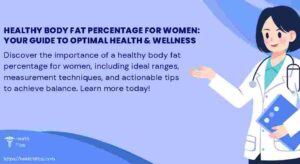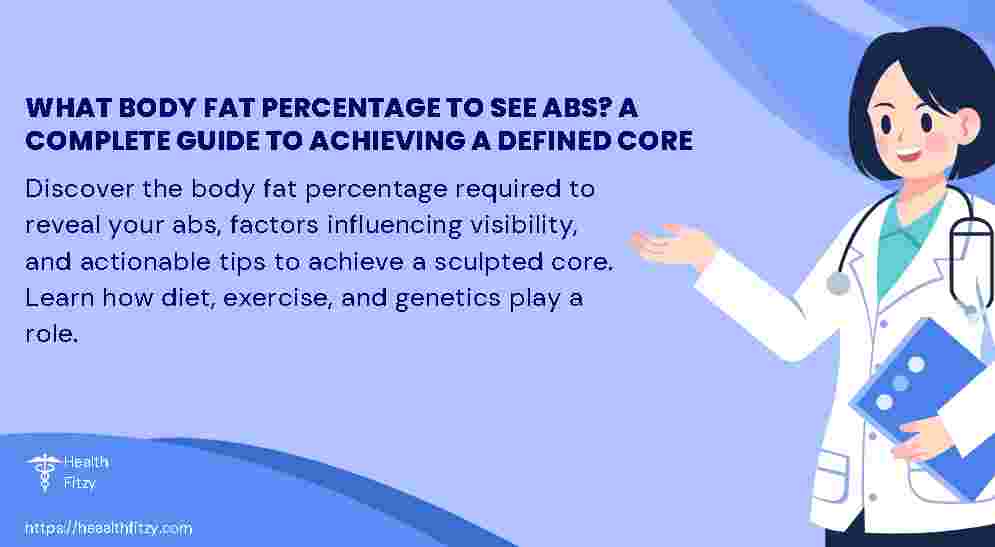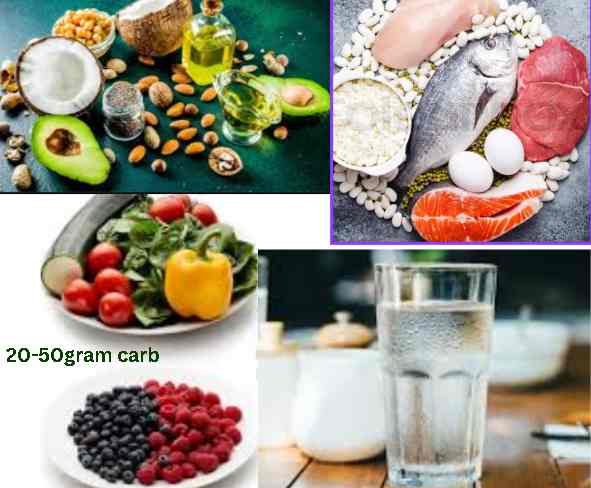what body fat percentage to see abs? A Complete Guide to Achieving a Defined Core
what body fat percentage to see abs: For many fitness enthusiasts, achieving visible abs is a hallmark of success. However, the journey to a defined core isn’t just about endless crunches—it hinges significantly on your body fat percentage. Let’s dive into the science, strategies, and factors that determine when your abs become visible.
Understanding Body Fat Percentage and Abs Visibility
Body fat percentage (BFP) measures the proportion of fat to total body weight. Since abdominal muscles lie beneath a layer of subcutaneous fat, lowering your BFP is essential to reveal them. Here’s a general breakdown:
-
Men: Abs typically become visible at 10–14% body fat (fully defined at 6–9%).
-
Women: Abs start showing at 16–20% body fat (defined at 14–17%).
These ranges vary based on genetics, muscle mass, and fat distribution. For example, some individuals might see abs at slightly higher BFPs due to favorable fat placement, while others may need to lean down further.
Why Genetics and Body Composition Matter
Your genetic blueprint plays a pivotal role in how and where fat is stored. Factors like:
-
Fat distribution patterns (e.g., apple vs. pear shape),
-
Muscle hypertrophy (core development),
-
Skin elasticity (tightness over muscles),
influence how quickly your abs become visible. Even at a low BFP, poor core development or loose skin can obscure definition.
How to Accurately Measure Body Fat
To track progress, use reliable methods:
-
DEXA Scan: Gold standard for accuracy.
-
Calipers: Affordable but requires skill.
-
Bioelectrical Impedance (BIA): Found in smart scales; less precise.
-
Visual Estimates: Compare photos to standardized charts.
Regular measurements help adjust your diet and training plan effectively.
Steps to Reduce Body Fat and Reveal Your Abs
1. Prioritize a Calorie Deficit
Abs are made in the kitchen! Consume 10–20% fewer calories than you burn. Focus on nutrient-dense foods like lean proteins, vegetables, and whole grains to maintain muscle mass.
2. Incorporate Strength Training
Compound lifts (squats, deadlifts) and targeted core exercises (planks, leg raises) build abdominal muscle, making them more prominent as fat decreases.
3. Add Cardiovascular Exercise
HIIT (High-Intensity Interval Training) and steady-state cardio (running, cycling) accelerate fat loss while preserving muscle.
4. Stay Consistent and Patient
Sustainable fat loss occurs at 0.5–1% of body weight per week. Crash diets can lead to muscle loss, hindering your progress.
Common Myths About Achieving Visible Abs
-
Myth 1: “Spot reduction works.”
Truth: You can’t target belly fat specifically; overall fat loss is key. -
Myth 2: “Everyone can get a six-pack.”
Truth: Genetics dictate ab symmetry and visibility potential.
Maintaining Your Results Long-Term
Once you’ve achieved visible abs, focus on:
-
Reverse Dieting: Gradually increase calories to avoid rapid fat regain.
-
Strength Maintenance: Continue resistance training to preserve muscle.
-
Flexible Nutrition: Allow occasional indulgences to stay mentally balanced.
FAQs About Body Fat and Abs
Q: Can you see abs without a low body fat percentage?
A: Only if you have exceptional core muscle mass, but most people require a reduced BFP.
Q: How long does it take to see abs?
A: Depending on starting BFP, 3–12 months with consistent effort.
Q: Do supplements help reveal abs?
A: They’re optional. Focus on protein intake and overall diet quality first.
Final Thoughts
Visible abs require a combination of low body fat, strong core muscles, and patience. While genetics set the playing field, disciplined nutrition and training can help most people achieve their goals. Remember, sustainability is key—prioritize health over shortcuts!
Healthy Body Fat Percentage for Women: Your Guide to Optimal Health & Wellness

What Is Body Fat Percentage?
What Is Body Fat Percentage: Body fat percentage measures the proportion of fat mass to total body weight. Unlike BMI, which only considers height and weight, body fat percentage distinguishes between fat and lean muscle, offering a clearer picture of health. For women, fat plays vital roles in hormone production, reproductive health, and protecting organs. Maintaining a healthy range is key to energy, longevity, and disease prevention.
Why Healthy Body Fat Matters for Women
Body fat isn’t just about aesthetics—it’s essential for bodily functions. Essential fat (10–13%) supports cell function and hormone regulation, particularly estrogen, which affects fertility and bone density. Too little fat can disrupt menstrual cycles, while excess visceral fat (around organs) increases risks of diabetes, heart disease, and inflammation. Striking a balance ensures metabolic efficiency and overall wellness.
Healthy Body Fat Ranges for Women
Women’s body fat needs vary by age, activity level, and genetics. General categories include:
-
Essential Fat: 10–13% (minimum required for survival).
-
Athletes: 14–20% (supports high physical activity).
-
Fitness Enthusiasts: 21–24% (balances muscle and health).
-
Average/Healthy: 25–31% (typical for non-athletes).
-
Above Average/Obese: 32%+ (linked to health risks).
Aim for a range aligning with your lifestyle and health goals. Consult a healthcare provider for personalized advice.
Factors Influencing Body Fat Levels
Age, genetics, and lifestyle all play roles. Muscle mass declines with age, slowing metabolism, while hormonal shifts (e.g., menopause) can increase fat storage. Genetics may predispose some to store fat in specific areas. However, diet, exercise, sleep, and stress management remain controllable factors for maintaining healthy levels.
How to Measure Body Fat Percentage
Common methods include:
-
DEXA Scan: Gold standard for accuracy, measuring bone, muscle, and fat.
-
Bioelectrical Impedance (BIA): Found in smart scales; convenient but less precise.
-
Skinfold Calipers: Affordable but requires skill for consistency.
-
Hydrostatic Weighing: Uses water displacement; highly accurate but less accessible.
Track trends over time using the same method for reliable insights.
Tips to Achieve a Healthy Body Fat Percentage
-
Prioritize Whole Foods: Focus on lean proteins, fiber-rich vegetables, and healthy fats (avocado, nuts) to fuel metabolism.
-
Strength Training: increases muscle mass, which increases resting calorie expenditure. Aim for 2–3 sessions weekly.
-
Cardio & HIIT: Boost calorie burn and heart health with cycling, swimming, or interval training.
-
Sleep & Stress Management: Poor sleep elevates cortisol, promoting fat storage. Aim for 7–9 hours nightly and practice mindfulness.
-
Avoid Extreme Diets: Rapid weight loss often sacrifices muscle. Opt for gradual, sustainable changes.
Debunking Body Fat Myths
-
Myth 1: “Spot reduction works.” Truth: Fat loss occurs globally; targeted exercises build muscle but don’t “melt” fat in one area.
-
Myth 2: “All fat is bad.” Truth: Subcutaneous fat (under skin) is less harmful than visceral fat (around organs).
-
Myth 3: “Lowest body fat = healthiest.” Truth: Extremely low levels risk hormonal imbalances and weakened immunity.
Conclusion
A healthy body fat percentage for women isn’t a one-size-fits-all number but a balance supporting physical and mental well-being. By understanding your unique needs, adopting sustainable habits, and avoiding quick fixes, you can achieve long-term health. Always consult professionals to tailor strategies to your body and goals.
Read also…
7-day diet plan for weight loss in hindi



